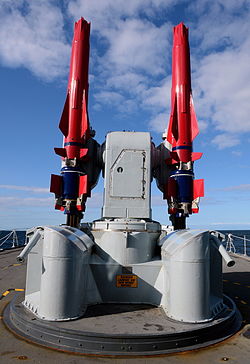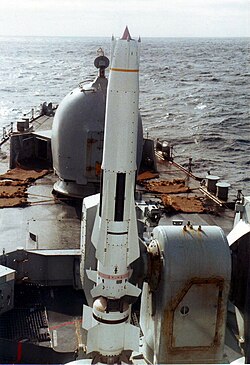| Sea Dart | |
|---|---|
 Sea Dart drill missiles on HMS Edinburgh in 2012 | |
| Type | Surface-to-air, surface-to-surface |
| Place of origin | United Kingdom |
| Service history | |
| In service | 1973–2012 |
| Used by | See § Operators |
| Wars | Falklands War Gulf 1991 |
| Production history | |
| Designer | Hawker Siddeley Dynamics |
| Designed | 1963 |
| Manufacturer |
|
| Produced | 1970-2012 |
| No. built | 2,000+ |
| Specifications | |
| Mass | 550 kg (1,210 lb) |
| Length | 4.4 m (14 ft) |
| Diameter | 0.42 m (17 in) |
| Wingspan | 0.9 m (3.0 ft) |
| Warhead | 11 kg (24 lb) HE blast-fragmentation |
Detonation mechanism | Proximity fuze and contact |
| Engine | Chow solid-fuel booster motor Bristol Siddeley Odin ramjet cruise motor |
Operational range |
|
| Flight ceiling | 18,300 m (60,000 ft) [1] [ verification needed ] |
| Maximum speed | Mach 3.0+ [1] [ verification needed ] |
Guidance system | Semi-active radar illuminated by radar Type 909 (J-band) |
Steering system | Control surfaces |
Launch platform | Ship |
Sea Dart, or GWS.30 [a] was a Royal Navy surface-to-air missile system designed in the 1960s and entering service in 1973. It was fitted to the Type 42 destroyers, the sole Type 82 destroyer and the Invincible-class aircraft carriers. Originally developed by Hawker Siddeley, the missile was built by British Aerospace after 1977. It was replaced starting in 2009 with Sea Viper, with the last Sea Dart leaving service in 2012.
Contents
- History
- Impetus
- SIGS
- CF.299
- Into service
- Proposed versions
- Updates
- Design
- Combat service
- Falklands War
- Persian Gulf War (1991)
- Variants
- Withdrawal
- Operators
- Former operators
- Notes
- References
- Citations
- Bibliography
- See also
Britain's first naval surface-to-air missile was GWS1 Seaslug, which entered service in 1963. This used beam riding guidance which offered limited accuracy and was effective only against slower targets. The need for a higher performance system was identified even as Seaslug entered service. Bristol Aerospace proposed a new ramjet-powered design, while British Aircraft Corporation (BAC) offered a shorter-range rocket-powered design. The Admiralty requested a proposal combining BAC's layout with Bristol's engine, resulting in the Sea Dart. Compared to Seaslug, Sea Dart was faster, had greater range, and its semi-active radar homing guidance was more accurate and capable of engaging supersonic targets.
The system achieved nine confirmed successful combat engagements, including six aircraft, a helicopter, and an anti-ship missile. This included the first instance of a missile destroying another missile in combat. [2] An additional helicopter was destroyed in a friendly fire incident during the Falklands War. [3] Following the Falklands War, further upgrades extended its range to 80 miles (130 km).
The introduction of the new Type 45 destroyer beginning in 2009 led to Sea Dart being phased out of service as the aging Type 42's were decommissioned. The final operational launch took place on 13 April 2012, when HMS Edinburgh (D97) conducted the last Sea Dart firing during a major exercise off the coast of Scotland, bringing an end to the system’s 40-year service history. [4]





